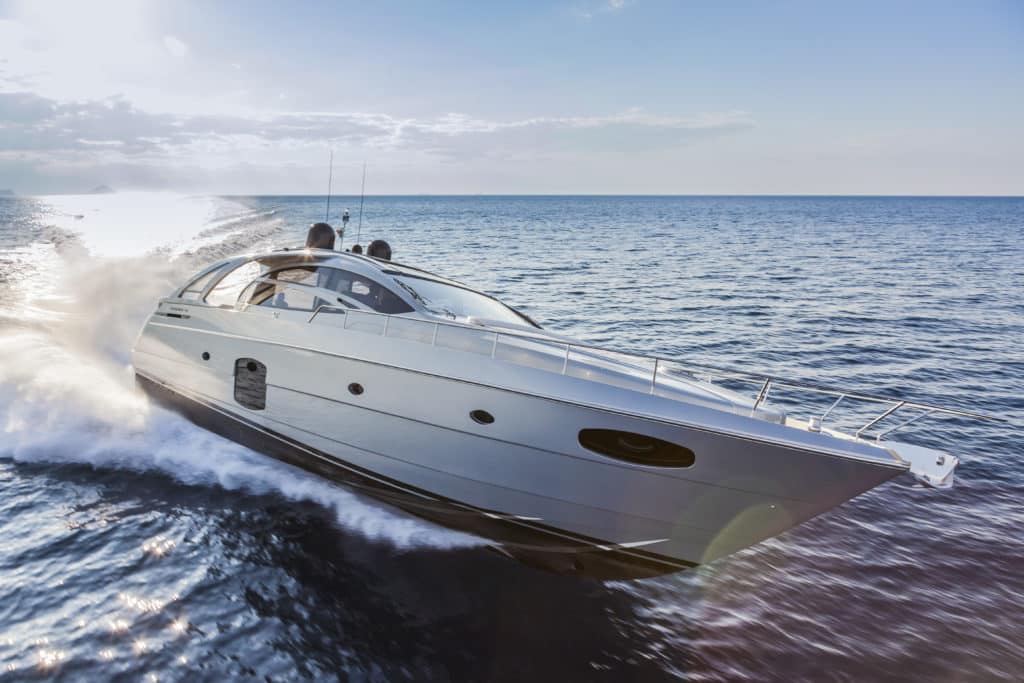
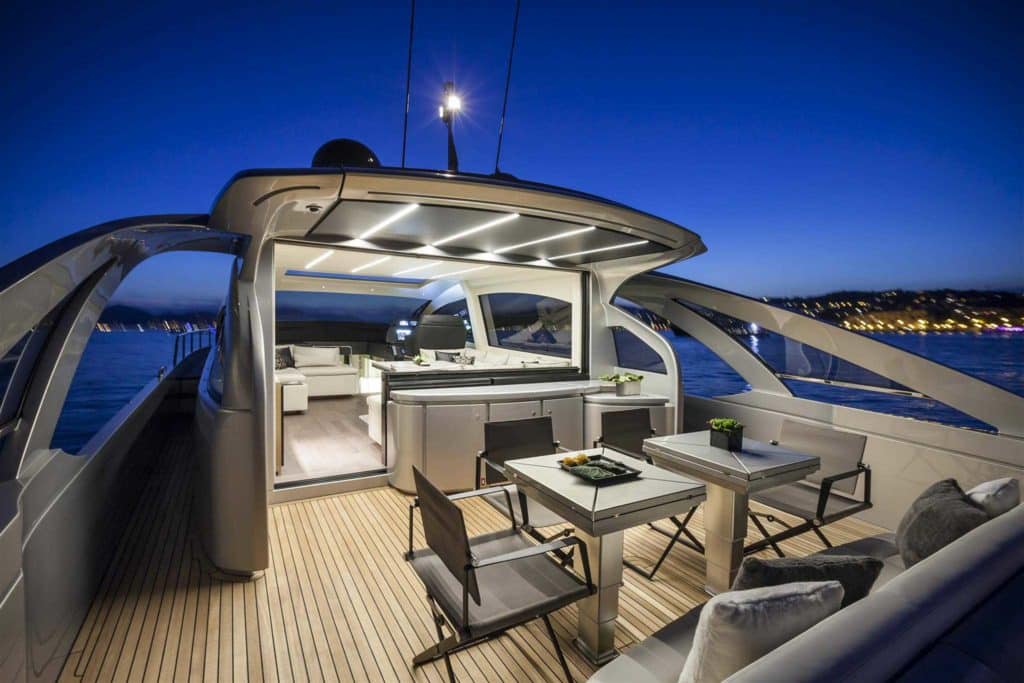
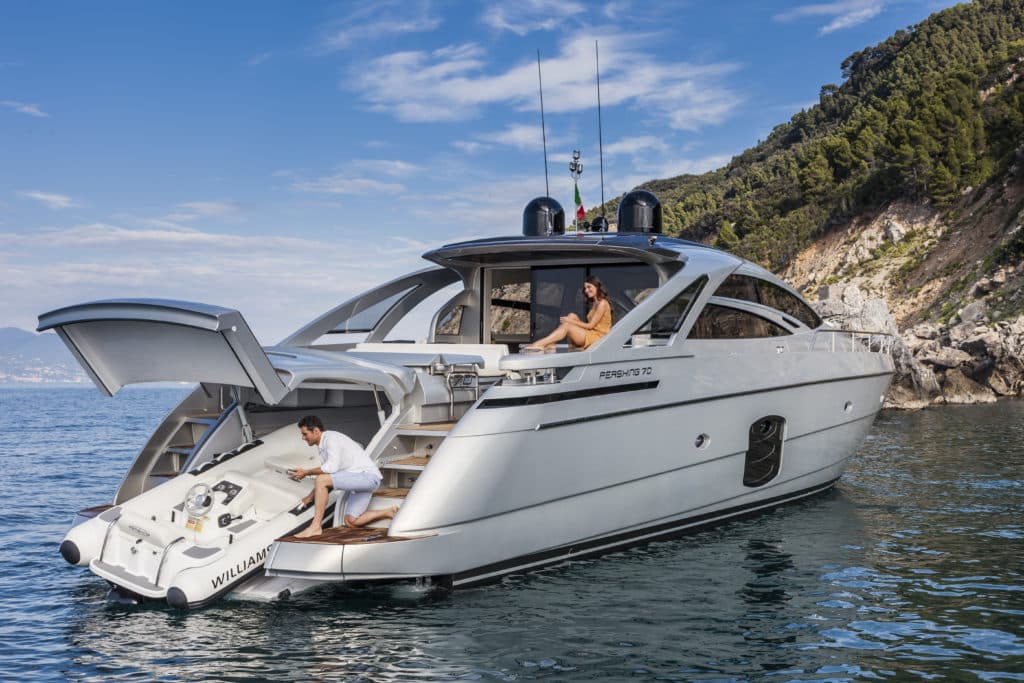
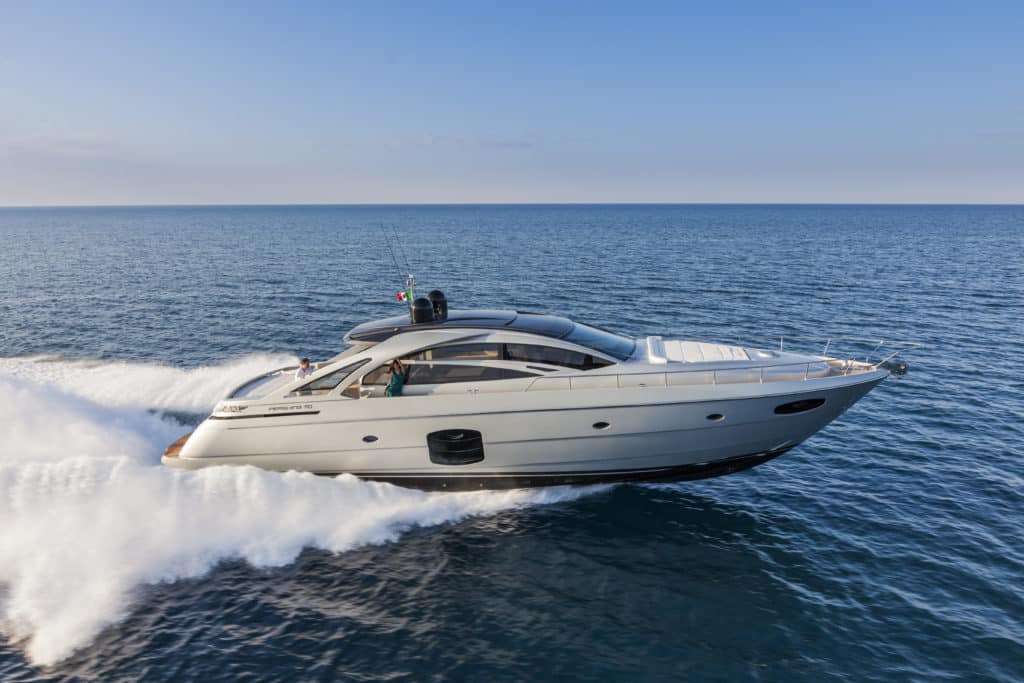
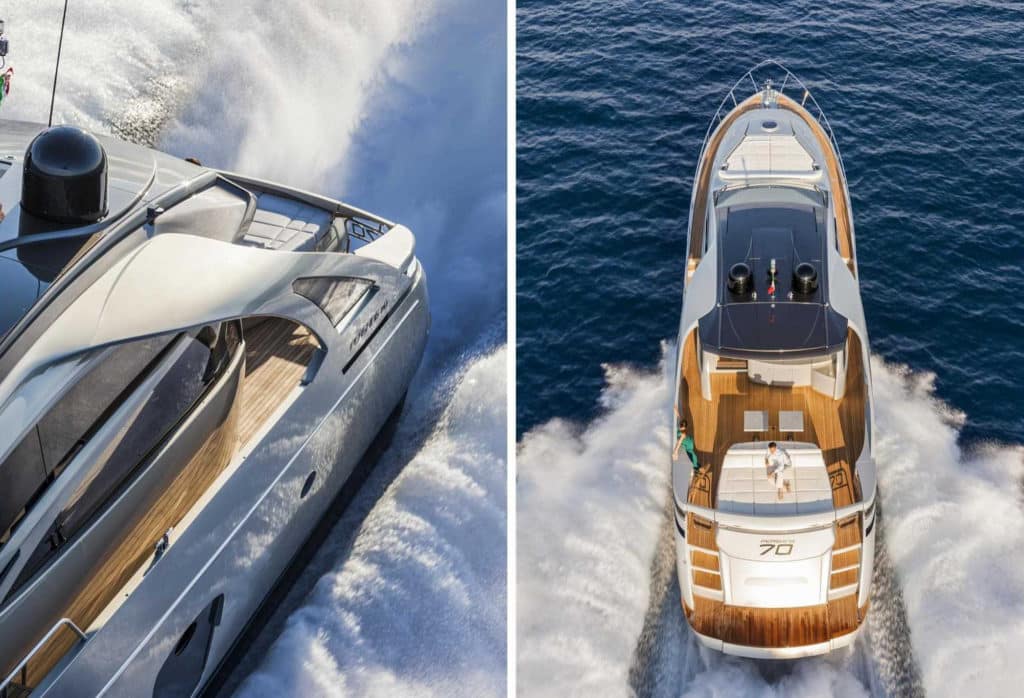
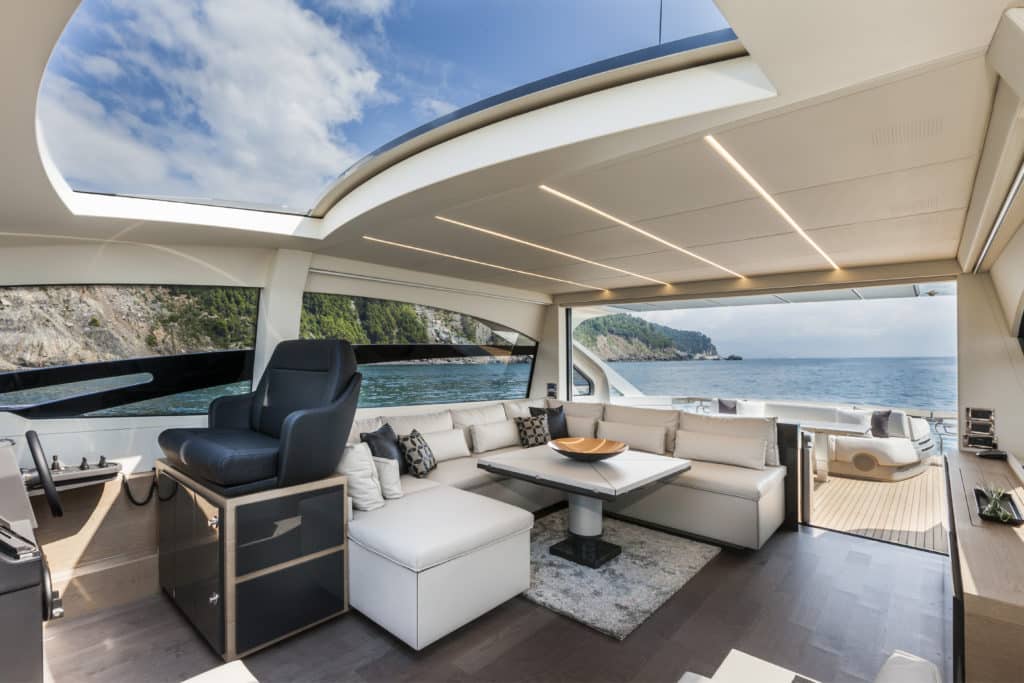
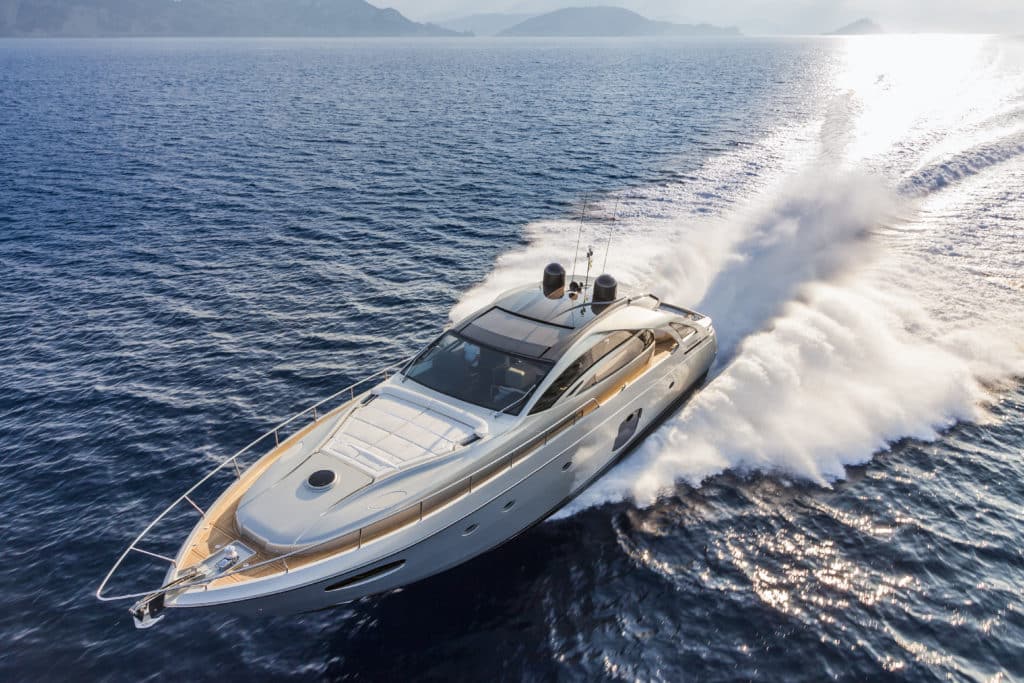
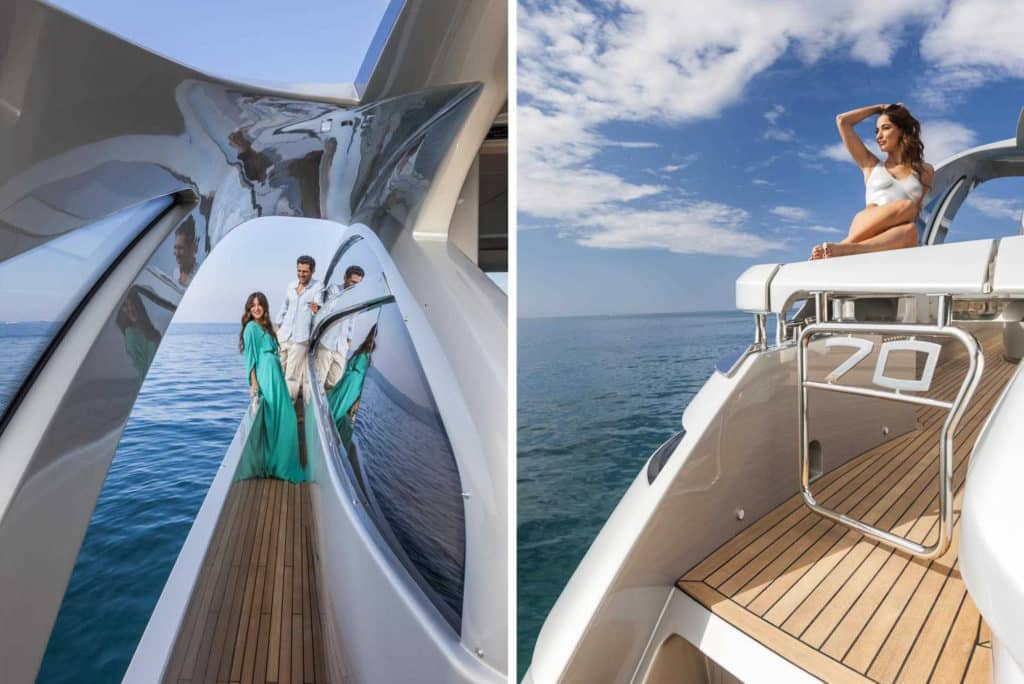
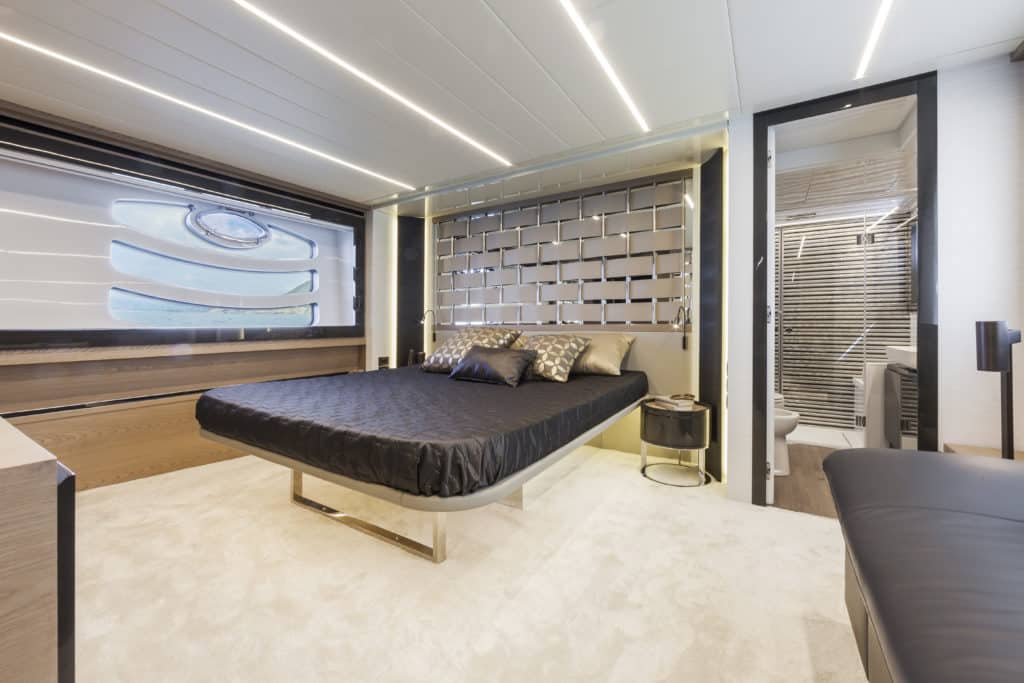
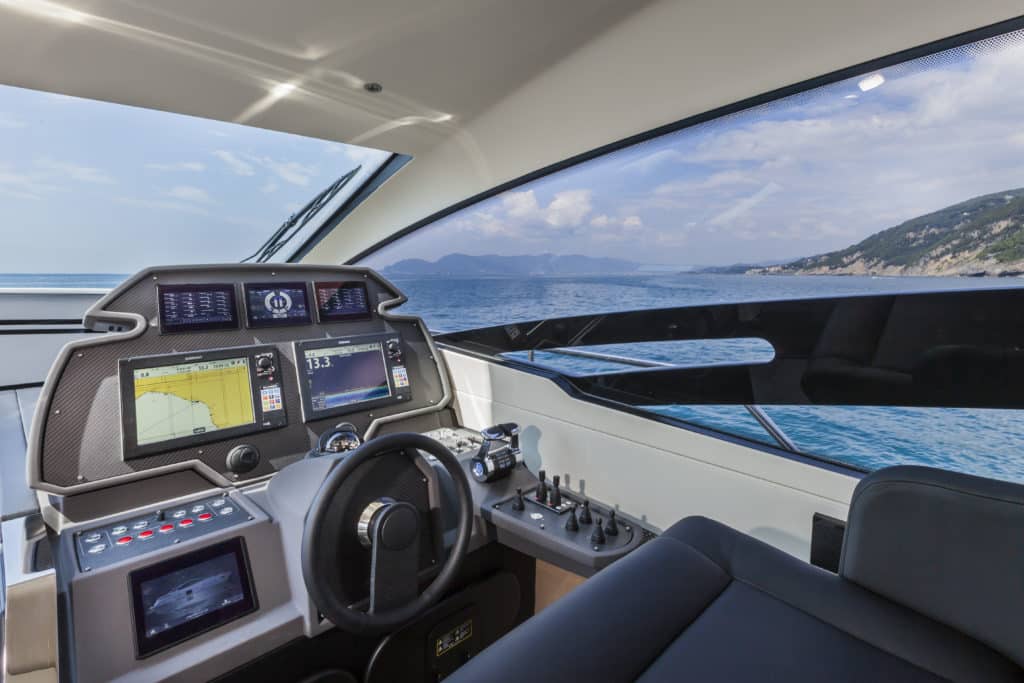
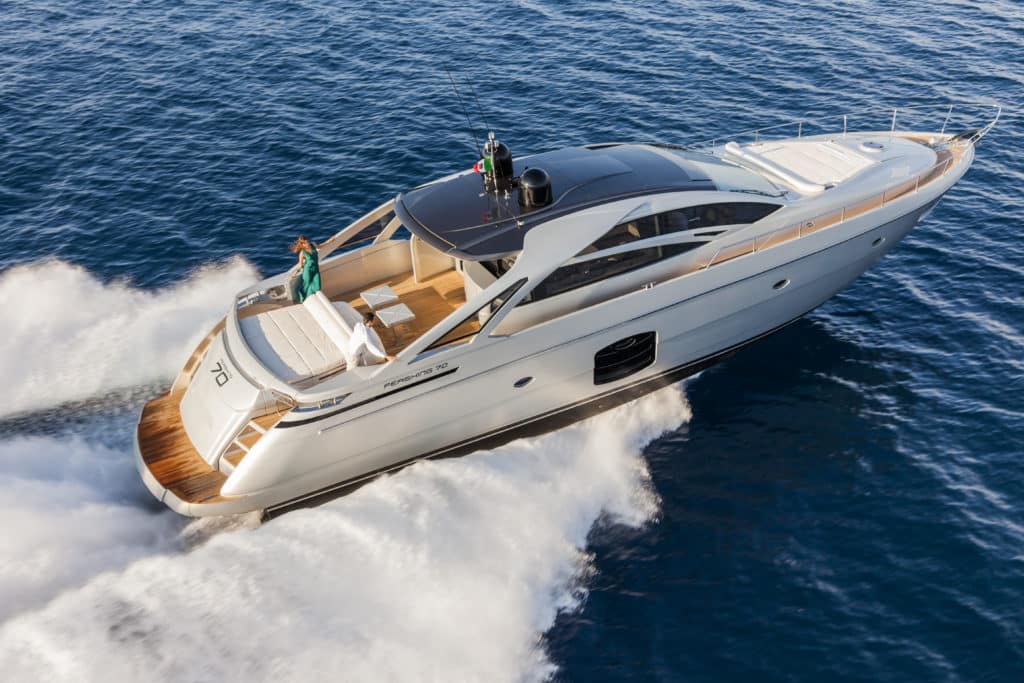
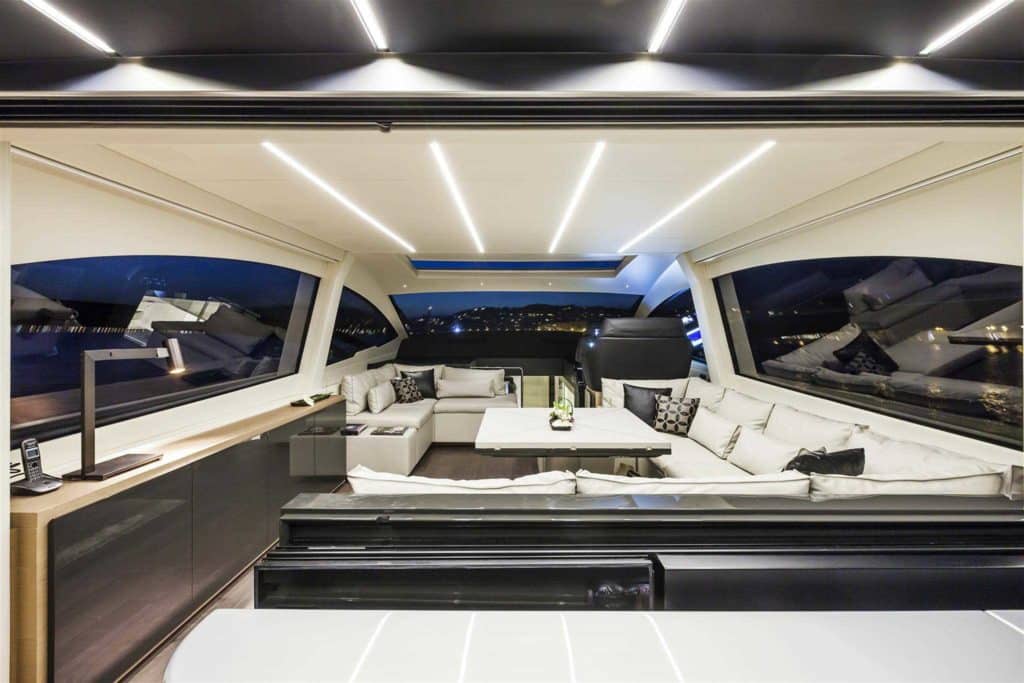
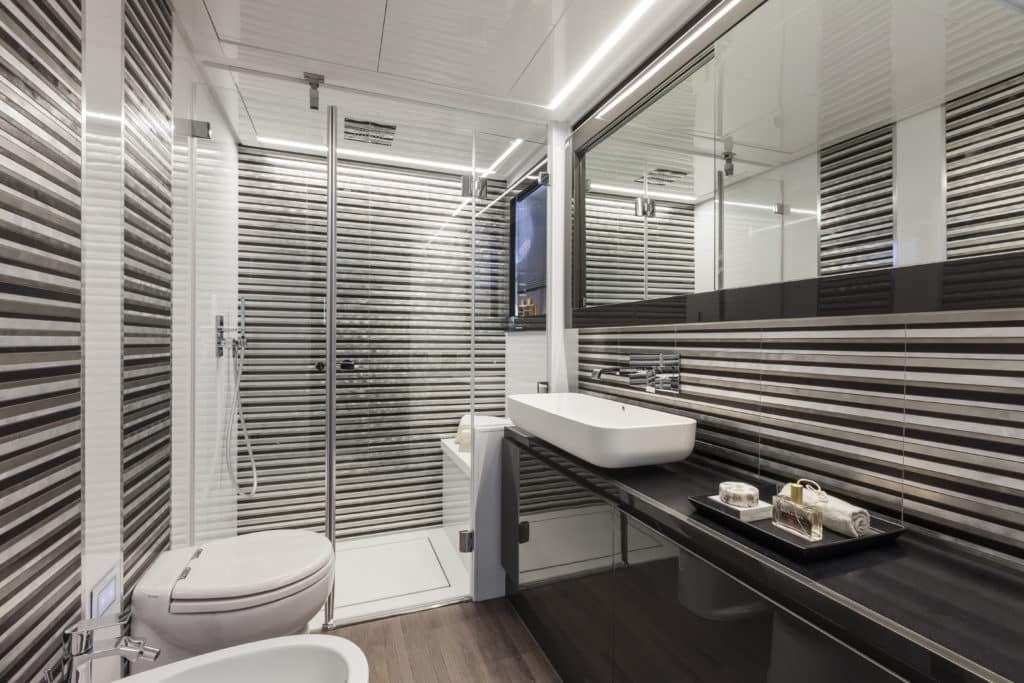
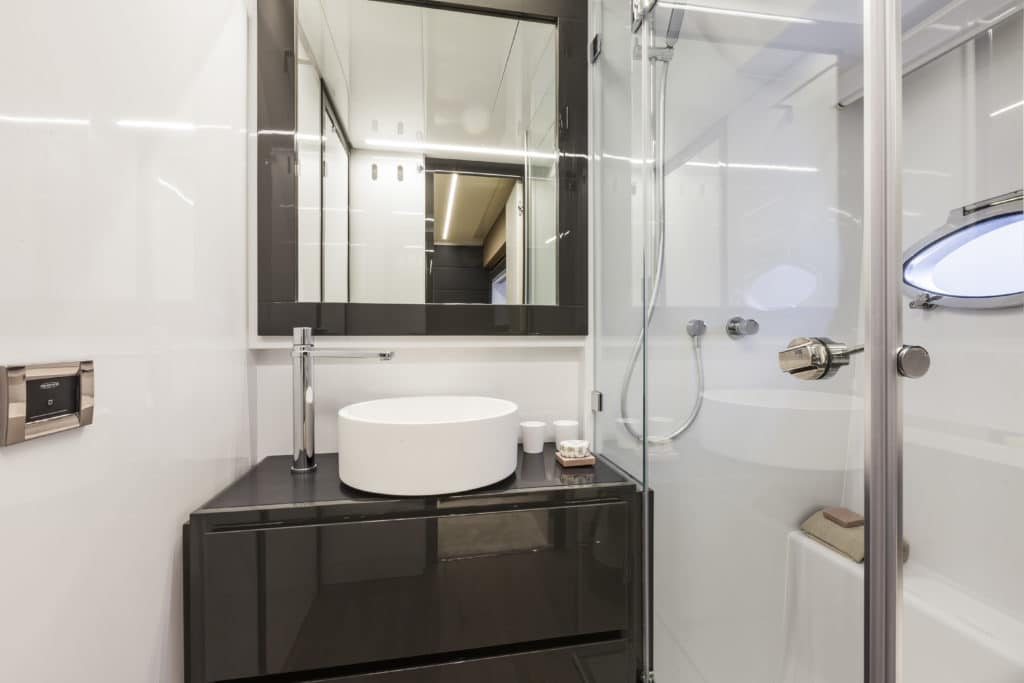
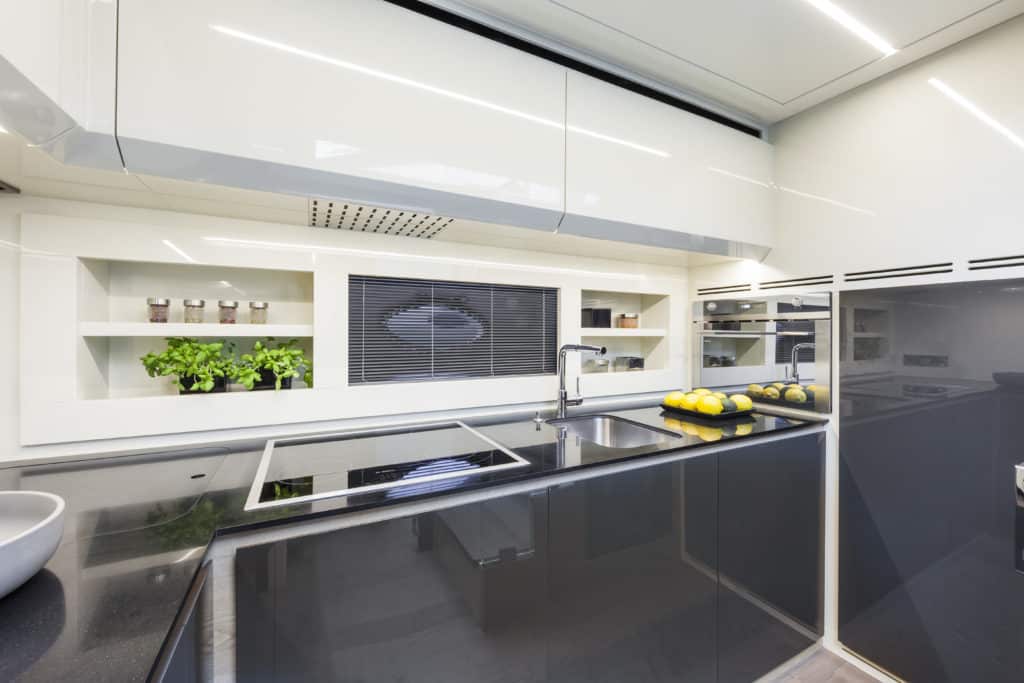
On a bright, sunny fall day off Cannes, France, I pushed the Pershing 70’s throttles to their stops. I felt a surge of performance as the twin 1,600-horsepower MTU 10V 2000 M94 diesels climbed up above 2,400 rpm. A light wind had roiled the coastal waters into a compact chop, which the 17-degree monohedral (constant deadrise) deep-V hull beneath my feet parted with ease. I glanced at the console and saw 46 knots staring back, and I have to admit it made me smile.
“Go ahead, make a hard turn,” said Marco Plicchi, Pershing brand manager. I reached up to pull the throttles back, and he said, “No, make the turn.”
I gave him a raised eyebrow, meant to question his sincerity. He nodded. With confidence.
I looked ahead, then aft through the space where a wall of glass had been lowered, then out both large side windows. No other traffic was nearby. So I turned the wheel to port, and the Pershing 70 banked smoothly into a tight turn like a Gulf-stream G650 turning to final approach. I briefly lost sight of the horizon out of the portside window but had a good view out of the open sunroof.
With the wheel back to center, what little speed we scrubbed off in the turn returned quickly. We caught up with our wake in quick fashion and knifed through it with a bit of a bang, but without discomfort for the crew. Absolutely exhilarating.
This boat was equipped with an optional automatic trim system, which vectored and trimmed the Top System surface drives precisely, reading the load of the big MTUs and the boat’s controls. The dedicated Autotrim screen was centered between two MTU electronic digital LCD engine control panels, just above the dual Simrad MFDs, and it was easy to monitor the changes going on with the drives behind. Just to the left of the wheel, a touch-screen display fed information on a host of domotics (home automation) and systems monitoring updates.
offshore warrior: the pershing build
Pershing Yachts enjoys an enviable reputation for strongly built hulls that can handle the high-performance, offshore-cruising mission. The hull and deck of the 70 are infused with vinylester resin and carbon fiber in the main frame to add strength without adding weight. Tanks are fiberglass, molded into the structure. The builder was accurate in its weight prediction through finite element analysis, which helped optimize every structure. The bottom is cored with end-grain balsa, while the sides, deck and superstructure are cored with closed-cell PVC foam. This all helps the Pershing 70 achieve 46 knots at wide-open throttle. — J.W.
After one last glance, I handed the wheel over to one of Pershing‘s captains and walked to the aft deck, where Plicchi was standing near the large sun pad. We were still moving along at high cruise, and I remarked that the wind here seemed preternaturally calm.
“We worked on many aspects of the wings to make them technically and aesthetically appealing,” Plicchi told me. “We wanted to have as much comfort in the cockpit as possible, to have the airflow flushing along the sides, to lower the backwind. We modified the shape three times and worked with Fulvio to add the glass inserts.” Fulvio De Simoni is the yacht designer behind every model Pershing builds, working with the Advanced Yacht Technology and Design office of parent company Ferretti Group and its design and decor firm, Centro Stile. Beginning with the Pershing 64 launched last year, there’s a new, more aggressive look to the latest models, including the 70 with its wings, which are both prominent and understated to my eye.
Adding wings separately meant more weight, gluing and fairing, so Pershing‘s designers and engineers molded the wings integrally with the deck and cabin superstructure. It’s a complex design that meant creating a mold with 19 pieces that must be assembled strongly before lamination begins, and then must be removed piece by piece to extract the molded part.
Designed from the beginning to run with surface-piercing drives, the 70 has Top System 85P drives — all stainless steel, precisely machined and welded, light and strong. The updated Autotrim, a third-generation unit that is user-friendly, works differently from previous iterations, relating position of the drives to trim tab settings and the load of engines — a more flexible setup taking into account whether the boat is heavy or light with fuel and owner equipment.
I pushed the Pershing 70’s throttles to their stops and felt a surge of power as the twin 1,600-horsepower MTU 10V 2000 M94 diesels climbed up above 2,400 rpm.
Back at the dock, Plicchi demonstrated the MOSFET (metal-oxide semiconductor field-effect transistor) system that uses one backbone cable to replace large bundles of wire to control lighting, air conditioning, entertainment and even window shade adjustment. Besides giving the owner complete, one-device control of all systems, which can be linked to an iPad, the system saves a considerable amount of weight and installation time.
“The basic MOSFET electrical system permits owners to have a fully automatic system controlling curtains, lights and air conditioning,” Plicchi said. “Another optional package controls shore power and gensets, keeping you apprised of your consumption. With a Bluetooth link, on iPad or iPhone, the passarelle can be extended or stored, although you must be within a 30-foot range so you can see what you’re doing. The system also has a Web-based option to notify you remotely if an alarm goes off, like if there’s water in the bilge, allowing you to reach out to local help or to visit the boat yourself to handle the situation.”
Pershing Yachts offer two designer-inspired layouts on the accommodations deck forward, both anchored by a full-beam master finished with leather, ash and plush moquette carpet. The VIP stateroom is finished similarly and, like the master, has an en suite head. A guest stateroom to port is available for those who need the extra berths, but it can be replaced with a comfy open sitting area.
ergonomic gem: A well-thought-out helm
Set well forward for excellent views ahead and to the sides, the helm is an ergonomic masterpiece. Sight lines are outstanding through 360 degrees. Poltrona Frau leather graces the helm’s double bench seat and the contemporary steering wheel, making extended periods on watch incredibly comfortable, whether sitting or standing. The electronic throttle/shift levers for engine control are well positioned for quick corrections, and the panel containing the joysticks for standard bow thruster, optional stern thruster, trim tabs and the Top System surface-drive trim are immediately below the throttles. Hydraulics for steering, surface-drive trimming and trim tabs is standard equipment. — J.W.
Fun to drive, thoroughly connected and gorgeous to look at, Pershing’s 70 is the next step forward in the builder’s heralded line of performance-oriented yachts. If you’re up for a test drive, set aside a day. There’s so much to see and do aboard, you’ll be glad you did.
Pershing Yachts; 954-462-5527
| Manufacturer Supplied Numbers | MTU 10V 2000 M94 3 cabins + 1 crew |
|---|---|
| LOA | 21,44 [m] – 70 ft 4 in |
| LH | 20,80 [m] – 68 ft 2 in |
| LWL | 17,14 [m] – 56 ft 2 in |
| Max beam | 5 [m] – 16 ft 4 in |
| Draft | 1,35 [m] – 4 ft 5 in |
| Unladen displacement | 41.500 [kg] – 91,491 [lbs] |
| Laden displacement | 47.340 [kg] – 104,366 [lbs] |
| Fuel | 3.500 [l] – 925 [US gal] |
| People on board | 16 |
| Engine | MTU 10V 2000 M94 |
| Engine HP | 1623 |
| Transmission | Surface Drives |
| Max speed | 46 [kn] |
| Cruise speed | 40 [kn] |
| Range | 280 [nm] |
| Cabins | 3 |
| Bathrooms | 3 |








